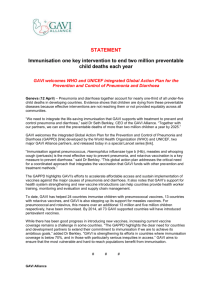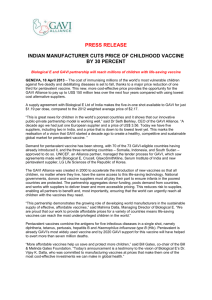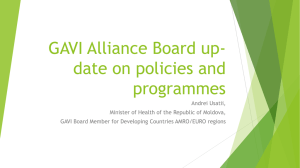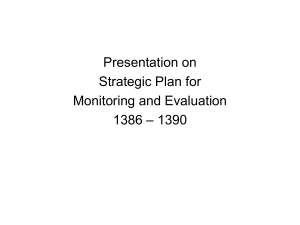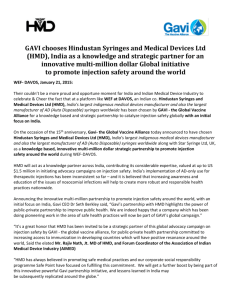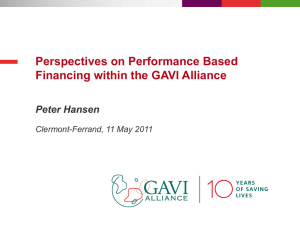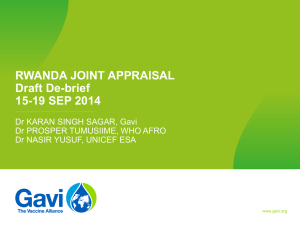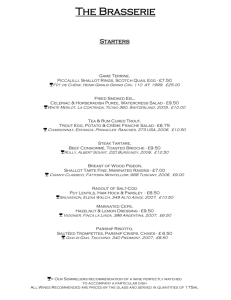Global Alliance for Vaccination and Immunisation
advertisement
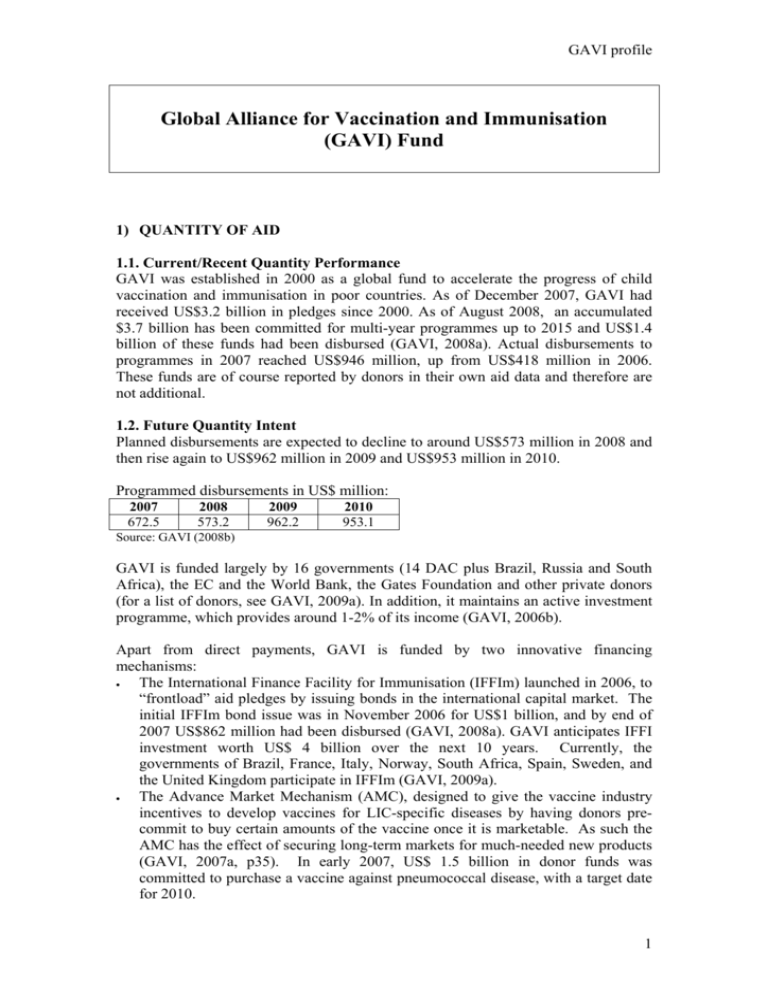
GAVI profile Global Alliance for Vaccination and Immunisation (GAVI) Fund 1) QUANTITY OF AID 1.1. Current/Recent Quantity Performance GAVI was established in 2000 as a global fund to accelerate the progress of child vaccination and immunisation in poor countries. As of December 2007, GAVI had received US$3.2 billion in pledges since 2000. As of August 2008, an accumulated $3.7 billion has been committed for multi-year programmes up to 2015 and US$1.4 billion of these funds had been disbursed (GAVI, 2008a). Actual disbursements to programmes in 2007 reached US$946 million, up from US$418 million in 2006. These funds are of course reported by donors in their own aid data and therefore are not additional. 1.2. Future Quantity Intent Planned disbursements are expected to decline to around US$573 million in 2008 and then rise again to US$962 million in 2009 and US$953 million in 2010. Programmed disbursements in US$ million: 2007 672.5 2008 573.2 2009 962.2 2010 953.1 Source: GAVI (2008b) GAVI is funded largely by 16 governments (14 DAC plus Brazil, Russia and South Africa), the EC and the World Bank, the Gates Foundation and other private donors (for a list of donors, see GAVI, 2009a). In addition, it maintains an active investment programme, which provides around 1-2% of its income (GAVI, 2006b). Apart from direct payments, GAVI is funded by two innovative financing mechanisms: • The International Finance Facility for Immunisation (IFFIm) launched in 2006, to “frontload” aid pledges by issuing bonds in the international capital market. The initial IFFIm bond issue was in November 2006 for US$1 billion, and by end of 2007 US$862 million had been disbursed (GAVI, 2008a). GAVI anticipates IFFI investment worth US$ 4 billion over the next 10 years. Currently, the governments of Brazil, France, Italy, Norway, South Africa, Spain, Sweden, and the United Kingdom participate in IFFIm (GAVI, 2009a). • The Advance Market Mechanism (AMC), designed to give the vaccine industry incentives to develop vaccines for LIC-specific diseases by having donors precommit to buy certain amounts of the vaccine once it is marketable. As such the AMC has the effect of securing long-term markets for much-needed new products (GAVI, 2007a, p35). In early 2007, US$ 1.5 billion in donor funds was committed to purchase a vaccine against pneumococcal disease, with a target date for 2010. 1 GAVI profile 2) KEY AGENCIES/MECHANISMS 2.1 Agencies and Structures (GAVI, 2007a, p64-67) GAVI consists of 5 separate entities, under the single leadership of its Executive Secretary and CEO. The GAVI Secretariat has two offices: one in Geneva (hosted by UNICEF) and one in Washington, both supporting the GAVI Alliance and Fund. In 2009 the Boards of the GAVI institutions will merge into a single entity, incorporated in Switzerland. The GAVI Alliance The GAVI Alliance is an unincorporated public–private partnership. It comprises partners including UNICEF, WHO, the Bill & Melinda Gates Foundation, the World Bank, developing & donor country governments, the vaccine industry, civil society organizations (CSOs), and research and technical health institutes. As of end-2006, there were 27 partners. The secretariat, based in Geneva, coordinates activities including policy development and support to countries. The Board governs policy development and implementation, and oversees all programmes. The Board includes four renewable members (UNICEF, WHO, the Bill & Melinda Gates Foundation, and the World Bank) as well as 12 rotating seats (four developing country governments, four donor country governments, and one each of research and technical health institutes, industrialized country vaccine industry, developing country vaccine industry, and CSOs). The GAVI Fund The GAVI Fund is a not-for-profit organization based in the United States of America, created to be the financing arm of the Alliance. The Fund coordinates the funding of Alliance activities from a variety of public and private sources. It has also various fiduciary responsibilities including asset management and investment, financial control, auditing and accounting. The GAVI Fund Board shapes the Alliance financial strategy to implement the GAVI Strategic Plan developed by the GAVI Alliance Board. The International Finance Facility for Immunisation (IFFIm) The IFFIm is a multilateral development institution established as a charity used to accelerate the availability of funds for the GAVI Alliance by issuing bonds backed by donor countries. A GAVI Fund Affiliate was established to enter into pledge agreements with IFFIm donors and assign these pledges to the IFFIm Company for eventual programme disbursement. The GAVI Fund Affiliate The GAVI Fund Affiliate was established to enter into pledge agreements with sovereign IFFIm donors and assign these pledges to the IFFIm Company for eventual programme disbursement. The GAVI Fund Affiliate is registered in England and Wales as a company limited by guarantee and as a charity with the Charity Commission for England and Wales. The GAVI Foundation The GAVI Foundation is a Swiss charitable foundation, with the mission to provide support for GAVI Alliance programmes and the GAVI Secretariat in Geneva. 2 GAVI profile 2.2 Key Policies and Documents GAVI Alliance Strategy 2007-10 (GAVI, 2006a) The 2007-2010 strategic plan positions the GAVI Alliance within the context of child survival, the MDGs and the UNICEF/WHO Global Immunization Vision and Strategy (GIVS) for 2006-15. It seeks to make a critical contribution to GIVS by supporting immunization programmes and health systems, as well as accelerating introduction of new vaccines. Strategic goals are: 1. Contribute to strengthening the capacity of the health system to deliver immunisation and other health services in a sustainable manner. 2. Accelerate the uptake and use of underused and new vaccines and associated technologies and improve vaccine supply security. 3. Increase the predictability and sustainability of long–term financing for national immunization programmes. 4. Increase and assess the added value of GAVI as a public-private global health partnership through efficiency, advocacy and innovation. GAVI’s Roadmap 2007-2010 (GAVI, 2006d) The roadmap translates the objectives of the 2007-10 Strategy into yearly milestones. 3) RECIPIENT COUNTRIES AND ALLOCATION CRITERIA 3.1. Recipient Countries Top 10 recipient countries 1 2 3 4 5 6 7 8 9 10 Ethiopia Pakistan Kenya Uganda Democratic Republic of Congo Nigeria India Bangladesh Malawi Ghana Cumulative approved support 2000-07 (US$m) 160.9 111.9 91.4 86.9 70.3 60.9 59.1 50.8 50.3 48.5 Source: GAVI (2008a) GAVI has provided grants to 73 countries. As of December 2007, the share of approved support to the top ten recipients amounts to 56% of the total. Distribution among different groups of recipients (% of five-year commitments to December 2005): Sub-Saharan Africa Asia Total 5-year commitments (US$ mio) 1,001 463 Share (%) 67.7 31.4 3 GAVI profile Europe Western Hemisphere Oceania Total Total 5-year commitments (US$ mio) 6 6 2 1,478 Share (%) 0.4 0.4 0.1 100 Source: GAVI (2006e). 3.2. Allocation Criteria 3.2.1. Pre-selection criteria In principle, GAVI provides assistance only to countries with a GNI per capita less than US$ 1000 (GAVI, 2006c). However, several countries with more severe health crises (DTP immunisation rates under 80%) within regional groupings, are included that would not qualify if the GNI per capita rule were strictly applied (GAVI, 2007d). As of February 2009, 72 countries are eligible for support (GAVI, 2009b). 3.2.2. Allocation criteria Funding allocation is based on need and absorptive capacity. Countries with lower DTP3 coverage, high numbers of unvaccinated children and large internal disparities will receive more resources (GAVI, 2006c). Countries with weak immunisation services where fewer than 50 percent of children are currently immunized against diphtheria, pertussis and tetanus can only receive financial support for these and DTP3 vaccinations. Tetanus/DTP3 coverage must reach 50 percent before such countries are eligible to receive HepB and Hib vaccines Continued support beyond the initial three years, is conditional upon results, notably increased vaccination coverage- as reported in a satisfactory Annual Progress Report. 4) AID POLICIES 4.1. Concessionality All GAVI resources are delivered to countries in the form of grants. 4.2. Types of Assistance Commitments to countries (2000-2015) as of December 2007 (in $USm): New and unused vaccines 2,600 Health system strengthening 409 Immunisation services 381 Injection safety 134 Source: GAVI 2008 GAVI funds are generally provided in sectoral project assistance, though they also provide direct commodity assistance (vaccines purchased by UNICEF and supplied directly to a country’s health sector). Since 2006, GAVI has started programmes to strengthen health systems. The Inter-Agency Coordinating Committee (ICC), which is the GAVI coordinating mechanism at the country level, can where appropriate be incorporated into sectoral coordination fora, e.g. SWAp type arrangements. 4 GAVI profile GAVI does not provide any Technical Assistance in-country. 4.3. Channels of Assistance GAVI resources are mainly directed towards recipient country Governments (95% in 2006, but only 65% in 2007 because more funds are allocated to vaccine development and stockpiling). However, in 2006 the Board agreed a Civil Society Initiative, to strengthen the representation and coordination of civil society organisations in 10 pilot countries with US$ 22 million in 2007 and 2008 (GAVI, 2007a, p12 and GAVI, 2007e). GAVI has recently become concerned to provide more support on-budget and as part of health sector programmes, in line with the Paris Declaration, rather than only providing vaccines via other agencies. As a result, its health system strengthening resources (1/3 of the total) are expected to be recorded on-budget in future years. 4.4. Sectors and Projects GAVI resources can only be used in the health sector. Apart from the purchase of vaccines, GAVI supports (i) immunisation services, (ii) injection safety, (iii) new & underused vaccines and (iv) (since 2006) health system strengthening. GAVI estimates that in 2007-10, vaccine purchase will make up two-thirds of spending, and health systems strengthening the remaining third (GAVI, 2007a, p26). Beginning in 2006, GAVI approved programmes specifically directed at strengthening health systems. 15 country proposals totalling US$ 117.6 million have been approved. Funding is based on the number of newborn infants in a given country. Once approved, the funds will be disbursed quickly to countries – in as little as three months – for flexible, non-exclusive grants to support the health workforce, supply, distribution and maintenance; and organisation and management GAVI (2007a, p36). 4.5. Flexibility GAVI provides funds exclusively for country-specific immunization and related (e.g. health system strengthening) activities. Hence resources are only allocated in the health sector and cannot be reallocated to another sector. They are programmed in advance and are therefore not flexible for relocation to support changing country priorities or to combat any exogenous (macro or emergency) shocks. 4.6. Predictability Funds are initially allocated for up to three years. If results are evaluated positively, funding can be extended for two more years, to a total of five (GAVI, 2007d). GAVI had committed to increase its funds predictability since the 2006 Paris survey as virtually no GAVI disbursements were on budget before 2005. Indicator 7 of the 2008 Survey shows some progress towards this goal and indicates some predictability in Cambodia (88% of aid was recorded and received on schedule) and Nepal (52%). HIPCs have not assessed GAVI regularly. 4.7. Conditionality GAVI has no prior (policy or process) conditionality. Instead, it relies on results delivery, allowing governments to set goals and monitor progress (GAVI, 2007b, 5 GAVI profile p11), with funding renewals for two more years after the initial 3 subject to evaluations of such results. Recipient countries indicate that GAVI’s outcome-based conditionality is laudable because its funding and activities are clearly linked to the production of the same results, making all sides fully accountable. As a result, all recipient countries but one (Liberia) have succeeded in meeting the results targets, and disbursements have been highly predictable. 4.8. Policy Dialogue GAVI plays a considerable role in national-level policy dialogue on immunisation policies and health systems. It coordinates national initiatives through the InterAgency Coordination Committee and increasingly through health sector programmes. There is however no link between GAVI disbursements and wider sectoral or macroeconomic programme targets, with only commitments dependent only on meeting GAVI targets. 5) AID PROCEDURES 5.1 Conditions Precedent Proposals and progress reports are screened by the GAVI Secretariat for completeness and eligibility. Thereafter each proposal and progress report is pre-assessed by a WHO expert group which looks at consistency and validity of data, and coordination with polio eradication and injection safety efforts. The group reports to the Independent Review Committee (IRC), which makes funding decisions. Grant allocation is dependent on (i) a well functioning inter-agency co-ordination Committee (ICC) or National Health Sector Coordination Body for Health Systems Strengthening (HSS), (ii) an application submitted by ministry of health, and endorsed by finance ministry and the relevant national coordination body, (iii) evidence that the proposed support from GAVI is fully synchronised with national planning and budgeting processes, and (iv) a comprehensive multi-year plan for immunisation, synchronized with a strategic health sector plan. Counterpart funding arrangements are being put in place for Phase II of GAVI (200710). The order of introduction of new vaccines will determine co-financing levels (see section 3.2). Countries will also be categorised into Least Poor, Intermediate and Poorest. For the first vaccine, countries will be requested to contribute a set price according to the country grouping, and for each subsequent vaccine co-financing per dose will increase. Least Poor countries are expected to scale up co-financing by 15% annually. Remaining countries can maintain 2007 levels up to 2010 after which they will be revised upwards gradually. Fragile and Post-Conflict states are exempt from co-financing (GAVI, 2006f). GAVI does not use any Project Implementation Units. However, ICC-approved bank accounts are required. 5.2 Disbursement Methods Once funding recommendations are approved, GAVI Fund staff requests all funds to be released in advance. Until 2006, around 75% of support was disbursed to UNICEF rather than to governments, for vaccine purchase. However, the 25% of funding for 6 GAVI profile Immunisation Service Support was disbursed directly from GAVI’s UNICEF trust account to recipients’ ICC-approved bank account in-country. This proportion is expected to increase to 1/3 given additional commitments to health systems support in 2007-10. 5.3 Disbursement Procedures Information on disbursement procedures is currently being compiled. According to Paris Indicator 5a, a third of GAVI’s funds use local Public Financial Management Systems, with the remaining 2/3 being accounted for by vaccine procurement through UNICEF. GAVI aims to have 90% of support accounted for within country Public Financial Management systems by 2010 (GAVI, 2007b, p14). 5.4 Procurement Procedures GAVI aid is untied. However, a significant share of procurement is voluntarily undertaken via UNICEF, which “bundles” purchases by recipient governments to procure under long-term arrangements with suppliers (thereby reducing costs). However, upon request, countries can procure supplies themselves (GAVI, 2005). GAVI (2007b) reports that it makes use of national procurement systems for only 2% of its disbursements. This is borne out by Paris survey indicator 5b, with only DRC (100%) and Moldova (60%) using recipient country procurement systems. GAVI has not set a 2010 target for this indicator, because of the centralisation of vaccine procurement through UNICEF (GAVI, 2007b, p15). 5.5 Coordination For Phase II, the Inter-Agency Coordinating Committee (ICC) is the institutional setup through which GAVI coordinates its programmes with country institutional structures. The ICC involves both the ministry of health and other partners in the field of immunization. GAVI support is further “planned for, implemented and monitored by the ICC in line with government plans and priorities” (GAVI, 2007a, p 14). Most important, as part of its health service support, GAVI plans to participate fully in health SWAps and to coordinate with other donors via these government-led structures. As for the Paris indicators 10a and 10b, GAVI reports that its missions are conducted jointly in Burkina Faso, Burundi, DRC, Cambodia, Nepal and Sudan. However it does not report any analytical work undertaken in the surveyed countries. Key sources (all internet sources were accessed in February 2009) GAVI (2005) “Procurement Services”, 16th GAVI Board – UNICEF contribution to GAVI/VF 2006-07 Work Plan Framework, accessed at www.gavialliance.org/resources/16brd_17a._Procurement_services_and_UNICEF_tr ust_account.pdf GAVI (2006a) “GAVI Alliance Strategy 2007-2010”, accessed at www.gavialliance.org/resources/GAVI_Alliance_Strategy__2007_2010_.pdf. GAVI (2006b) “The GAVI Alliance Accounts Combined Financial Statements 7 GAVI profile For the Year Ended December 31, 2005”, accessed at www.gavialliance.org/resources/GAVI_Combined_Financial_Statements_2005.pdf GAVI (2006c), “International Finance Facility for Immunisation – Programme Overview”, accessed at www.gavialliance.org/resources/FS_IFFlm_Programme_Over_Aug06_en.pdf GAVI (2006d) “GAVI’s Roadmap 2007-2010”, accessed at www.gavialliance.org/resources/2007_10_Roadmap_final.pdf GAVI (2006e) “5-year Commitments”, accessed at www.gavialliance.org/resources/5yr_commitment_Dec05.xls GAVI (2006f) “Proposed New Vaccine Financing Policies”, GAVI Alliance Board Telecon, 28 July 2006, accessed at www.gavialliance.org/resources/tel_28Jul2006_VaccineFiPols.pdf GAVI (2008a) “GAVI Alliance Progress Report 2007”, accessed at www.gavialliance.org/resources/2007GAVIreport.pdf GAVI (2008b) “2009-10 GAVI Alliance Work Plan and 2009 Admin Budget” www.gavialliance.org/resources/9._Work_Plan.ppt GAVI (2007d) “The GAVI Alliance”, accessed at www.gavialliance.org/resources/FS_GAVI_Overview_Feb07_web_EN.pdf GAVI (2007e) “Enhancing civil society participation in GAVI Alliance governance and programme implementation 2007-2008, GAVI secretariat background paper”, accessed at www.gavialliance.org/resources/HSS_TOR_and_mandate_Feb07.doc GAVI (2008a) “GAVI Alliance Progress Report 2007”, accessed at http://www.gavialliance.org/resources/2007GAVIreport.pdf GAVI (2008b) “2009-10 GAVI Alliance Work Plan and 2009 Admin Budget” www.gavialliance.org/resources/9._Work_Plan.ppt GAVI (2009a), “Donor contributions and commitments”, accessed at http://www.gavialliance.org/support/donors/index.php GAVI (2009b), “Eligible countries”, accessed at http://www.gavialliance.org/support/who/eligible/index.php WHO and UNICEF (2005) “Global Immunization Vision and Strategy”, accessed at www.who.int/vaccines-documents/DocsPDF05/GIVS_Final_EN.pdf 8
